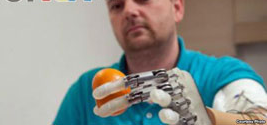VOA慢速英语:猴子可以用意念移动虚拟的胳膊
From VOA Learning English, this is the Technology Report.
Monkeys have learned to move the arms of a monkey on a computer screen just by thinking about moving them. The work moves forward efforts to develop brain control devices for people who are paralyzed or unable to move certain parts of their body.
 |
| Large-scale brain activity from a rhesus monkey was decoded and used to simultaneously control reaching movements of both arms of a virtual monkey avatar towards spherical objects in virtual reality. Photo: Duke Center for Neuroengineering |
Researchers have developed software that runs between the monkey's brains and a machine. They hope it could someday be used to let someone with the spinal cord injury control an artificial arm or leg just by thinking about it.
The software was developed by researchers at the Center for Neuroengineering at Duke University in Durham, North Carolina. Early vesions of the software could control only one artificial limb. But the new software let rhesus monkeys move two arms at the same time, as they watch a likeness of themselves on a computer screen.
Miguel Nicolelis is a Neurobiology professor at Duke. He says the monkeys first learned to control the limbs on the computer screens using joysticks, then they were trained not to move.
"They are trained just to imagine the movements. And we get the signals from both parts of their brains - both hemispheres - to be routed to a computer that's running a computer algorithm that translates their voluntary will to move into movements of a virtual body," Nicolelis said.
 |
|
Amputee Dennis Aabo wearing sensory feedback enabled prosthetic in Rome, March 2013. (Lifehand 2 / Patrizia Tocci) |
Professor Nicolelis says scientists are now developing a clothing that can be controlled by the brain. It would permit the person wearing the clothing to control artificial limbs. The device changes electrical signals from the brain into commands, and then into digital signals that machine in the clothing can understand.
Professor Nicolelis says the vest will be showed at the 2014 World Cup in Brazil later this year.
And we hope to make a demonstration during the opening ceremony by having a young paraplegic, a Brazilian adult, to walk into the field using this vest, controlled by brain activity and being in charge of the opening kick-off of the World Cup," he said.
You can find an article on the research in the journal Science Translational Medicine.
In a separate but related story, a Danish man has become the first amputee to experience feeling in his artificial hand. Dennis Aabo lost his hand to fireworks nine years ago. Since then, he has used a prosthetic hand.
Last year, researchers in Italy and Switzerland attached sensors to the fingers of the artificial hand. They then wired the sensors to the nerves in Aabo's upper arm. Researchers say the experiments proved promising, but they say many years of work remains.
An article on that research also appears in the journal Science Translational Medicine.
And that is the Technology Report from VOA Learning English. I'm June Simms.
- 频道推荐
- |
- 全站推荐
- 推荐下载
- 网站推荐




















